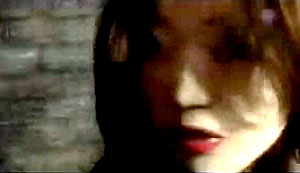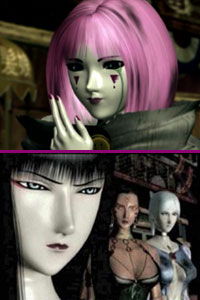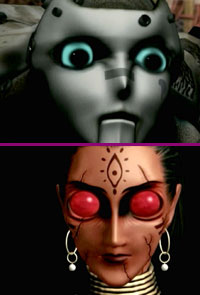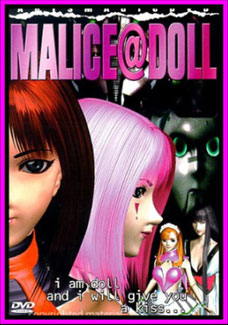 Marronnier (2004) is a not-so-hot Japanese film about dolls or mannikins that are alive. A weird young man captures young women & turns them into dolls, dressing them in very frilly dresses.
Marronnier (2004) is a not-so-hot Japanese film about dolls or mannikins that are alive. A weird young man captures young women & turns them into dolls, dressing them in very frilly dresses.
He is quite obviously a pervert about it, & there's a tone of festishism about the entire film, though it's too chaotically edited without sufficient clarity to really know, let alone much care, what it's all about or what motivations might be.
For no useful reason the script is convoluted & impossible to follow, which sort of spoils the whole effort. It's a cheezy-cheap film but the dolls are odd enough it could've been great fun if it made just a tad more sense, or if the main characters had more personality.
The essence of the thing is the insane young man, Iwata (played by a one-name one-film wonder, "Ochyazukenori"), really didn't expect the dolls to come to life, let alone seek revenge against him. They had formerly been beautiful young women, but he developed a process that turned them into dolls he thought he could control, but he was wrong.
 It is gruesomely campy at a couple points, & rather like a gory, silly cartoon or comic book, but with actors & props instead of drawings. It is gruesomely campy at a couple points, & rather like a gory, silly cartoon or comic book, but with actors & props instead of drawings.
The protagonist, young doll collector named Marino (another one-name one-film wonder, "Mayu"), never exhibits enough individuality to carry the confused story very well, but her attempts to not be turned into a doll are suspenseful enough to get by.
Among her own dolls is her favorite Marronnier (French for horse chestnut), whose face gets cracked so that she's the only "evil" looking doll in the film.
Through Marino's puppeteer brother Kurataro (played by the director himself), the film becomes partly an amateur rock video with some absolutely terrible music tossed in. It was hard to tell if the music was supposed to be so bad, as a joke, though I suspect the writer-director-producer-actor, who is also the composer, thinks he made some good music. It somehow has that smack of delusion.
 As to the dolls, some of them are pretty creatures, mainly they have that cutesiness of actual Japanese toys, which has the effect of making their capacity for violence disorientingly effective. As to the dolls, some of them are pretty creatures, mainly they have that cutesiness of actual Japanese toys, which has the effect of making their capacity for violence disorientingly effective.
The best scenes are unintentionally the goofiest, & for eccentricity alone the film is likeable, despite that it is chaotic in structure & poorly made.
The human characters are superficially oddballs, but the acting is terrible, which keeps the dolls more interesting than the people. Indeed, on the dvd is a seven-minute short subject, The Legends of Marronnier (2004), which features dolls & mannikins exclusively, & is much more entertaining than the feature film because there are no bad actors dragging it down.
In the short film, two of the dolls become superheroines to save another doll from the broken-faced evil doll, who is Marronnier. There is lots of spoofing of kaiju monster movies & the puppetry is charming.
 Malice@Doll (2000) made no particular splash when it was new, & was a commercial dud. Almost a decade later it was salvaged from obscurity, restored & rearranged a bit, given an English language vocal track (with the original Japanese plus subtitles also on the dvd), & given new life in the English & North American marketplace.
Malice@Doll (2000) made no particular splash when it was new, & was a commercial dud. Almost a decade later it was salvaged from obscurity, restored & rearranged a bit, given an English language vocal track (with the original Japanese plus subtitles also on the dvd), & given new life in the English & North American marketplace.
The snail or at-sign in the title is not sounded out, & kind of ridiculous. Nor does the heroine's name Malice mean she is malicious or bad; the name was apparently chosen because it rhymes with Alice, as in Wonderland.
Malice Doll is the name of the heroine, a lifesize sex doll of a crumbling dystopian future where humans seem to have died out & artificial intelligences carry on as best they can, with their purposes of serving humanity unfulfilled.
Malice Doll wanders the streets of a malfunctioning, apparently underground metropolis, but as a streetwalker never encounters clients, since humans are extinct.
The bizarre future-city has existed in this state of decay for so long that many dolls repose "off line" with no signs of life Malfunctions a commonplace. Even Malice Doll, who is not as bad off as many others, walks with a limp, needs to find the repair robot in the maze of the city, & has sprung a tear-like leak of coolant from one eye.
The first third of the film is not terribly interesting. Malice as a character is whiny, repetitious, & her identity crisis upon discovering she's become organic goes on much too long.
 She never does become particularly convincing or interesting, but the surrealism of the design & the final act's complete crazily of monstrous aestheticism makes it ultimately rewarding to plod through. She never does become particularly convincing or interesting, but the surrealism of the design & the final act's complete crazily of monstrous aestheticism makes it ultimately rewarding to plod through.
Essentially while search for the repair robot she encounters a ghost-girl (whose purpose is never clarified) & a tentacled being (apparently an alien) who rips Malice to pieces as she asks politely not to be destroyed. She soonafter awakens with a human body & has to convince sundry dolls & other mechanical creatures she's still Malice.
Human Malice is prone to emotional fits. She also still seems largely programmed as a sexual servitor, & can only offer to kiss the dolls, for some lesbo doll action. But now her kiss infects other mechanized intelligences with organic transformation, though unlike her, those she kisses & changes turn out monstrous, though the method leaves the monsters somehow happy.
As a work of surrealism it's possibly intentional that none of it makes any real sense. As work of symboism the viewer has to work at imposing meaning. Malice goes from robotic servant, to organic whiner, to someone eager to transform others, to the realization that she is creating chaos & must find the root cause of what has happened.
Admin Joe, who seems to be a sort of mayor robot, at first tries to stop what is happening, but then becomes curious to know what organic creatures feel & see. By then, however, Malice no longer wants to transform mechanical beings into organic creatures, since it never comes out well.
 She finds the root source of the changes that occurred to her & through her to many others. She undergoes another transformation, not an especially interesting, & spends the end of the film singing & flying. She finds the root source of the changes that occurred to her & through her to many others. She undergoes another transformation, not an especially interesting, & spends the end of the film singing & flying.
None of it is ever explained but it seems to be related to the fable of the philosopher who dreamed he was a butterfly, unless he was actually a butterfly dreaming himself a philosopher.
The real point of this anime seems to be semi-pornographic for the filmmakers' compatriot doll fetishists, with Malice having flashbacks to the sadomasochistic encounters she experienced when humans still existed.
In the history of anime this is one of the earliest feature length uses of computer animation. As such it is very limited animation with many design tricks & a bit of cell animation tossed in to make the illustrated world seem a bit mroe animate than is the case. The distinction between organic & mechanical doesn't always work because the computer graphics fail to capture any sense of the organic, so even transformed sex dolls still look like sex dolls.
The design is sometimes imaginative but never brilliant. The dolls themselves are reminiscent of much older cell-animated cartoon girls who always have big eyes, with none of the advances anime underwent to become credibly dramatic & character-driven. Monsters are more interesting than the sex-dolls (if less pretty) but editing tricks to disguise how little actual animation there is makes it hard to appreciate even what is well imagined.
I'm fond of very little anime & this one didn't for me rise above the standard low average. It is not the same-old-stuff though, & fans already devoted to anime ought to find much to appreciate in Malice@Doll.
Continue to:
Legend of the Doll (2006)
copyright © by Paghat the Ratgirl
|


 It is gruesomely campy at a couple points, & rather like a gory, silly cartoon or comic book, but with actors & props instead of drawings.
It is gruesomely campy at a couple points, & rather like a gory, silly cartoon or comic book, but with actors & props instead of drawings. As to the dolls, some of them are pretty creatures, mainly they have that cutesiness of actual Japanese toys, which has the effect of making their capacity for violence disorientingly effective.
As to the dolls, some of them are pretty creatures, mainly they have that cutesiness of actual Japanese toys, which has the effect of making their capacity for violence disorientingly effective. Malice@Doll (2000) made no particular splash when it was new, & was a commercial dud. Almost a decade later it was salvaged from obscurity, restored & rearranged a bit, given an English language vocal track (with the original Japanese plus subtitles also on the dvd), & given new life in the English & North American marketplace.
Malice@Doll (2000) made no particular splash when it was new, & was a commercial dud. Almost a decade later it was salvaged from obscurity, restored & rearranged a bit, given an English language vocal track (with the original Japanese plus subtitles also on the dvd), & given new life in the English & North American marketplace. She never does become particularly convincing or interesting, but the surrealism of the design & the final act's complete crazily of monstrous aestheticism makes it ultimately rewarding to plod through.
She never does become particularly convincing or interesting, but the surrealism of the design & the final act's complete crazily of monstrous aestheticism makes it ultimately rewarding to plod through. She finds the root source of the changes that occurred to her & through her to many others. She undergoes another transformation, not an especially interesting, & spends the end of the film singing & flying.
She finds the root source of the changes that occurred to her & through her to many others. She undergoes another transformation, not an especially interesting, & spends the end of the film singing & flying.